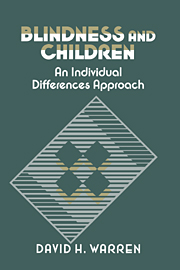Book contents
- Frontmatter
- Contents
- Preface
- Introduction
- Part I Interaction with the physical world
- 1 Perception of the physical world
- 2 Motor and locomotor interaction with the physical world
- 3 Understanding the physical world
- 4 Spatial understanding and spatial behavior
- Part II The acquisition of cognitive skills
- Part III Adapting to the social world
- Part IV Summary
- Conclusion
- References
- Author index
- Subject index
2 - Motor and locomotor interaction with the physical world
from Part I - Interaction with the physical world
Published online by Cambridge University Press: 02 December 2009
- Frontmatter
- Contents
- Preface
- Introduction
- Part I Interaction with the physical world
- 1 Perception of the physical world
- 2 Motor and locomotor interaction with the physical world
- 3 Understanding the physical world
- 4 Spatial understanding and spatial behavior
- Part II The acquisition of cognitive skills
- Part III Adapting to the social world
- Part IV Summary
- Conclusion
- References
- Author index
- Subject index
Summary
In order to interact with the physical world effectively, the child must acquire motors skills, including travel as well as haptic exploration and manipulation. Success clearly depends in part on the effectiveness of perceptual skills, which we reviewed in Chapter 1; just as clearly, concepts of spatial relations must be involved.
Our approach is to treat first the infancy period, focusing on reaching and grasping, then locomotion. Then we move to issues of motor and locomotor development in the postinfancy period. Finally, we turn briefly to the phenomenon of stereotypic behaviors in children with visual impairments.
Infancy
Reaching and grasping
Our focus is on the manner in which the infant reaches for and grasps objects. These activities clearly depend on physical control of the musculature, but in addition, a fundamental prerequisite for these behaviors is adequate processing of the perceptual information that emanates from objects, whether that stimulation comes via the auditory, the visual, the tactual, or even the olfactory sense.
For sighted infants, a major milestone in this development typically occurs around four to five months of age, when the infant begins to reach for interesting objects that are seen. Reaching for objects that are only heard typically emerges later, in the last third of the first year (Freedman, 1971; Freedman, Fox-Kolenda, Margileth, & Miller, 1969).
What is the situation for infants with visual impairments? Manual behaviors. The evidence is mixed with respect to two major indices, bimanual midline activity and reaching for objects.
- Type
- Chapter
- Information
- Blindness and ChildrenAn Individual Differences Approach, pp. 30 - 61Publisher: Cambridge University PressPrint publication year: 1994



